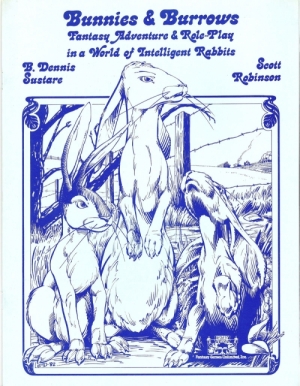I started to feel that I didn’t know roleplaying games well enough so I came up with the plan to read a roleplaying game corebook for every year they have been published. Selection criteria is whatever I find interesting.

Bunnies & Burrows is one of the earliest roleplaying games ever published, originally appearing in 1976. I read the 1st edition but in the 1982 printing by Fantasy Games Unlimited, with a new cover. Bunnies & Burrows is the original roleplaying game about intelligent animals. I’ve contributed to this genre too with my game about penguins, Valley of Eternity.
The game draws obvious inspiration from Watership Down. The characters are bunnies who live in a hazardous woodland environment full of danger. The game is fairly serious, with all kinds of trouble just around the corner. The list of animals who wish to eat the characters is fairly long.
Bunnies & Burrows is very simulation-oriented. The characters leave their burrow and explore their environment. They meet other animals, survive traps set by humans and communicate with other bunnies.
One of the fun things about reading early roleplaying games is seeing terminology that hasn’t settled into accepted conventions yet. Here, NPCs are called “cardboard characters,” presumably because they’re less three-dimensional than player characters. Character classes are always expressed in a peculiar way. The book never says that someone belongs to a specific class. Rather, the word is “declared”. Thus, I would say: “I’ve declared my character a Maverick”. In D&D you’d say: “I’ve declared my character a Fighter”.
Each character in Bunnies & Burrows belongs to one of the eight character classes, grouped to match the eight basic stats. These are the same as in D&D, with the addition of Speed and Smell. Classes include Runner, Seer and Storyteller.
Herbalism plays a big part in the game and the idea is that players don’t know the rules in advance. They’ll learn through trial and error, or from the advice of cardboard characters. Different herbs must be prepared in specific ways to get a desired effect. The descriptions of the methods of preparation are rather fun. They include Lick, Squeeze, Crumble and Pick bugs. Not exactly high alchemy!
At the end of the booklet, there are rules for a few different games of gambling for bunnies. They’re complicated by the fact that bunnies can only count to four. Thus, a bunny of low morals can exploit the bad math skills of their brethren and win by using specific methods.